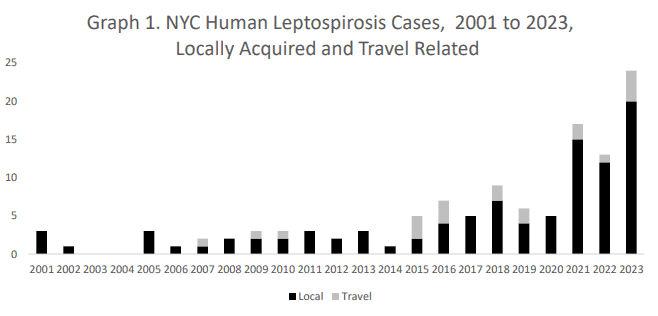A life-threatening infection spread through rat urine seems to be on the rise in New York. Although only a few cases of leptospirosis are reported each year, New York City officials are concerned about the uptick in cases. This zoonotic disease, primarily spread by urban rat populations, made the city’s Department of Health and Mental Hygiene issued an alert regarding the record number of incidents in 2023 and a continuing upward trend in 2024.

Rats and bacteria
An urban legend claims that for every New Yorker, there are five rats. In fact, rats are so widespread in NYC that they’re considered a cultural symbol of the city. Recent estimates put the number of rats in New York City at around 3 million. That’s nowhere near what the local legend claims — but still a huge number.
New York City has been battling rat infestations for decades with varying degrees of success in rat control and mitigation. The city’s dense population and vast subway and sewer systems provide an ideal habitat for rats. Efforts to control the rat population have included enhanced sanitation measures, public awareness campaigns, and more stringent building maintenance regulations. However, the persistence and adaptability of rats make them a formidable challenge for the city.
The problem is not so much the rats themselves, but the diseases they can carry. Rats carry a lot of diseases including potentially lethal ones such as leptospirosis, hantavirus, and the bubonic plague, posing serious health risks to humans and other animals.
Leptospirosis is a bacterial disease caused by Leptospira bacteria and is considered a global health concern. In urban settings like New York City, the disease is most commonly transmitted through direct contact with environments contaminated by rat urine, where the bacteria propagate.
An upward trend
The disease has not really been a major concern until recently. Between 2001 and 2020, the number of cases hovered at around 3-4 per year. But something seemed to change during the pandemic, triggering the Department of Health to issue a warning.
“The number of human leptospirosis cases continues to trend upwards; twenty-four cases were reported in New York City (NYC) in 2023—the highest number in a single year. In 2024, 6 cases have been reported to date,” the warning reads. It added that “human leptospirosis infections in NYC are largely associated with exposure to environments and materials contaminated with rat urine.

To put it into perspective, 20 cases are not that much. Ten times more people get killed by cars and a hundred times more people get killed by pollution. But the increase is concerning, particularly as it seems to be trending even higher.
How to fight leptospirosis
Leptospira bacteria are “fragile”, says the NYC Health Department. They get killed in minutes in dry heat or freezing temperatures. So, naturally, there are far fewer cases in the winter. However, the extra humidity and “unseasonably warm temperatures” that come with climate change support the persistence of the bacteria in urban environments.
To combat the spread of leptospirosis, the NYC Health Department has implemented several preventive strategies. These include public education on avoiding contact with potentially contaminated water, soil, and food, and rigorous enforcement of sanitation and building maintenance codes to mitigate rat habitats.
People are also advised to be aware of potential symptoms like fever, headache, chills, vomiting, diarrhea, jaundice, and rash. The incubation period is usually around 5-14 days. Without treatment, the condition may become life threatening.
Health professionals are advised to initiate treatment promptly with suitable antibiotics, as recommended by the Centers for Disease Control and Prevention (CDC), to manage and possibly curtail severe manifestations of the disease.
It’s not just New York City, either. Studies show that leptospirosis has become more common in several parts of the world, including South America and Europe.
With climate change posing a continual threat and urban areas growing more densely populated, the challenges associated with controlling diseases like leptospirosis are likely to increase. A proactive stance, such as the one taken by the Health Department, is essential to ensure that this type of problem doesn’t escalate into a full blown health crisis.






